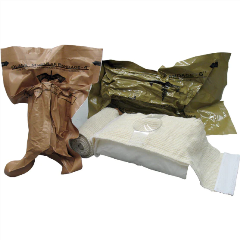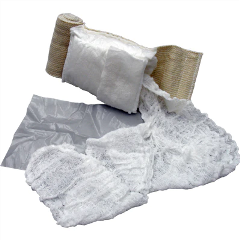
- The OLAES modular trauma dressing and Israeli Bandage are specifically designed haemorrhage control dressings used to establish and maintain traumatic wound haemostasis in the pre-hospital setting.
- It is a sterile elasticised bandage with a non-adherent pad sewn in one end. The non-adherent pad is placed directly onto the wound and the bandage is fed through a pressure applicator before bandaging in the opposite direction.
- Reverse bandaging causes the pressure applicator to flatten, placing direct pressure on the wound.
- A closure bar at the end of the bandage enables simple and effective securing without the need for pins, tapes or knots.
- Traumatic wounds requiring haemostasis
- Before using the trauma bandage to stop bleeding, pack the wound with hemostatic gauze. This will cause the blood to clot faster and put more pressure on the wound.
- When unrolling the bandage, try not to touch the white sterile absorption pad to keep it as clean as possible before applying it to the wound.
- When dealing with deep cuts or punctures in the chest, most external bleeding will not be life threatening, and internal bleeding requires emergency hospital care.
Head
Pressure bandages can even be used on the head, but a creative wrapping technique is required to secure it. Bandages applied to wounds on the scalp will tend to slip upwards along the curve of the head.
- Apply the non-adherent pad directly to the wound.
- Insert the bandage into the pressure applicator.
- Firmly pull the bandage in the opposite direction, wrapping at least twice around the head.
- Hooking the wrapping leader behind a corner of the pressure applicator, wrap the Israeli bandage under the chin once to keep it in place.
- Loop the Israeli bandage roll behind the top end of the pressure bar to change the wrapping direction.
- Secure the hooking ends into the bandage.
Chest
- In case of open pneumothorax or penetrating chest trauma, utilise the chest seal; if no chest seal is available, the foil of the trauma bandage can be used in its place. Ensure that the sterile side of the packaging is facing the wound. Be careful that the package lies smooth over the wound with no creases or folds; this should be an airtight seal.
- Once the chest wound is sealed, the technique for wrapping the chest is similar to that for the limbs.
Abdomen
Abdominal wounds do not require a great deal of pressure given there is no bone to against which to apply pressure. The purpose of an abdominal dressing is to keep the wound sterile and prevent infection.
- Remove the bandage from the packaging and remove the plastic barrier if not required (the plastic barrier is considered suitable for exposed organs or burns).
- Place the non-adherent absorption pad over the wound, noting that a dry pad that adheres to the wound will burst the formed blood clots when the bandage is removed.
- Wrap the bandage firmly around the torso, bringing the bandage to the front of the body.
- Wrap the bandage, covering the top half of the non-adherent dressing and insert into the pressure applicator.
- Reverse the direction of the bandaging and wrap the bandage to cover the bottom half of the pad.
- Continue wrapping until all edges of the pad are covered.
- Secure the wrapping leader by hooking the closure bar into the previous layer of the bandage.
Limbs
Non-amputation
- Place the pad directly on the wound and wrap the bandage one revolution around the limb.
- Slip the elastic bandage through the slot in the pressure applicator and pull it tight.
- Pull the elastic bandage, forcing the pressure bar to light flat on the pad.
- Continue to wrap the elastic bandage tightly around the patient and over the pressure bar making sure to cover the entire absorption pad.
- Once the absorption pad is completely covered, twist the elastic wrap so that it forms a cord.
- Stick the closure bar under one of the cords with the hooks facing down.
- Twist the closure bar like a tourniquet windlass to increase the pressure on the wound.
- When the bleeding is controlled, hook the closure bar to the bandage to secure it in place.
Amputation
- Remove the bandage from the packaging and remove the plastic barrier if not required.
- Place the stump of the amputated limb into the centre of the non-adherent dressing and encase it in the bandage.
- Wrap the bandage around the limb and insert the bandage into the pressure applicator.
- Pull the bandage firmly in the opposite direction and continue bandaging, covering all edges of the non-adherent pad.
- Leave 2-3 unwrapped revolutions of the wrapping leader.
- Twist the unwrapped elastic bandage into a cord and wrap around the limb.
- Insert the closure bar between the wrapped cords and rotate to effect (akin to the windlass of a tourniquet).
- Secure the wrapping leader with the hooks of the closure bar.


| Settings | |
|---|---|
| Extended Care: | |
| Colour assist: | |
Document Control
Clinical Resources Website
St John Ambulance Western Australia Ltd (ABN 55 028 468 715) (St John WA) operates ambulance and other pre-hospital clinical services. St John WA’s Clinical Resources, including its Clinical Practice Guidelines (Clinical Resources), are intended for use by credentialed St John WA staff and volunteers when providing clinical care to patients for or on behalf of St John WA, within the St John WA Clinical Governance Framework, and only to the extent of the clinician’s authority to practice.
Other users – Terms of Use
The content of the St John WA Clinical Resources is provided for information purposes only and is not intended to serve as health, medical or treatment advice. Any user of this website agrees to be bound by these Terms of Use in their use of the Clinical Resources.
St John WA does not represent or warrant (whether express, implied, statutory, or otherwise) that the content of the Clinical Resources is accurate, reliable, up-to-date, complete or that the information contained is suitable for your needs or for any particular purpose. You are responsible for assessing whether the information is accurate, reliable, up-to-date, authentic, relevant, or complete and where appropriate, seek independent professional advice.
St John WA expressly prohibits use of these Clinical Resources to guide clinical care of patients by organisations external to St John WA, except where these organisations have been directly engaged by St John WA to provide services. Any use of the Clinical Resources, with St John WA approval, must attribute St John WA as the creator of the Clinical Resources and include the copyright notice and (where reasonably practicable) provide a URL/hyperlink to the St John WA Clinical Resources website.
No permission or licence is granted to reproduce, make commercial use of, adapt, modify or create derivative works from these Clinical Resources. For permissions beyond the scope of these Terms of Use, including a commercial licence, please contact medservices@stjohnambulance.com.au
Where links are provided to resources on external websites, St John WA:
- Gives no assurances about the quality, accuracy or relevance of material on any linked site;
- Accepts no legal responsibility regarding the accuracy and reliability of external material; and
- Does not endorse any material, associated organisation, product or service on other sites.
Your use of any external website is governed by the terms of that website, including any authorisation, requirement or licence for use of the material on that website.
To the maximum extent permitted by law, St John WA excludes liability (including liability in negligence) for any direct, special, indirect, incidental, consequential, punitive, exemplary or other loss, cost, damage or expense arising out of, or in connection with, use or reliance on the Clinical Resources (including without limitation any interference with or damage to a user’s computer, device, software or data occurring in connection with such use).
Cookies
Please read this cookie policy carefully before using Clinical Resources from St John WA.
The cookies used on this site are small and completely anonymous pieces of information and are stored on your computer or mobile device. The data that the cookies contain identify your user preferences (such as your preferred text size, scope / skill level preference and Colour Assist mode, among other user settings) so that they can be recalled the next time that you visit a page within Clinical Resources. These cookies are necessary to offer you the best and most efficient possible experience when accessing and navigating through our website and using its features. These cookies do not collect or send analytical information back to St John WA.
Clinical Resources does integrate with Google Analytics and any cookies associated with this service enable us (and third-party services) to collect aggregated data for statistical purposes on how our visitors use this website. These cookies do not contain personal information such as names and email addresses and are used to help us improve your user experience of the website.
If you want to restrict or block the cookies that are set by our website, you can do so through your browser setting. Alternatively, you can visit www.internetcookies.com, which contains comprehensive information on how to do this on a wide variety of browsers and devices. You will find general information about cookies and details on how to delete cookies from your device. If you have any questions about this policy or our use of cookies, please contact us.